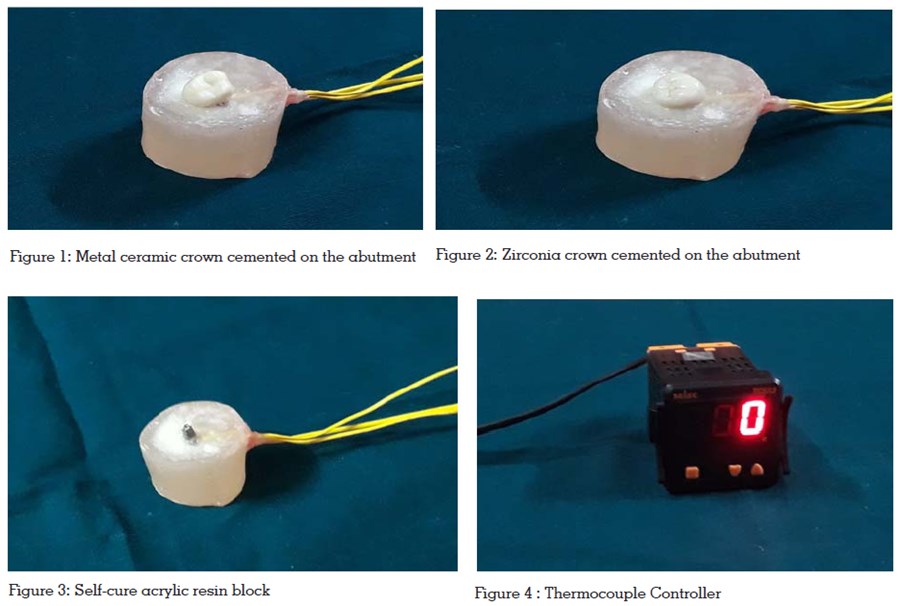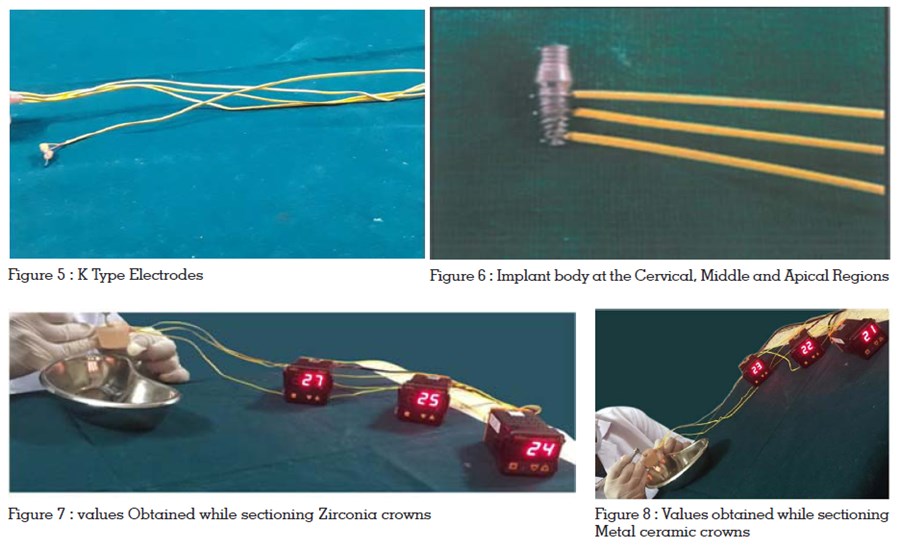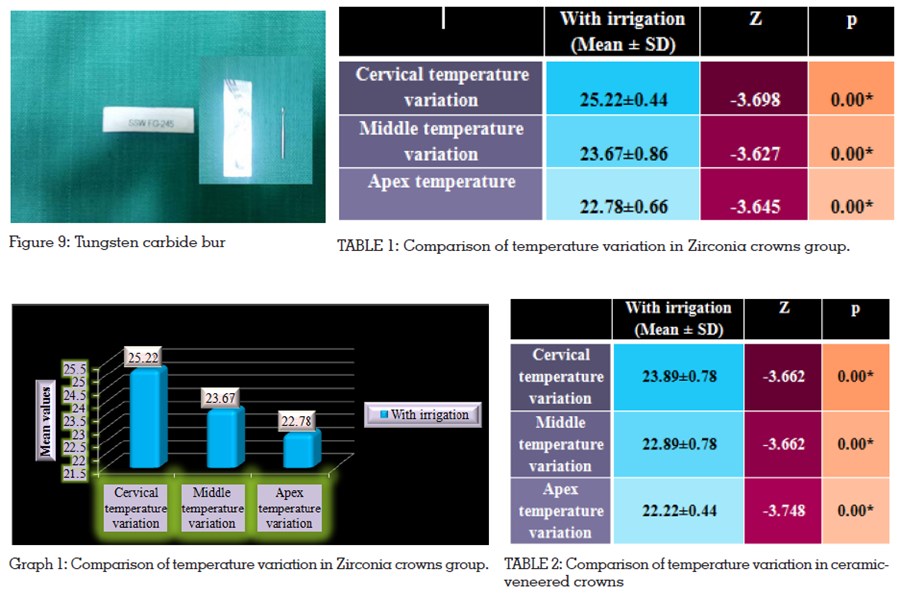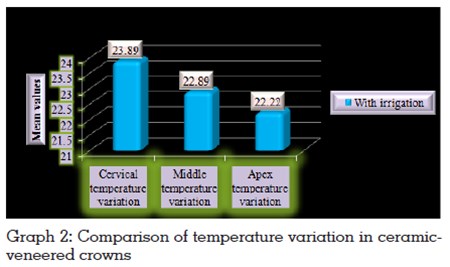

The direct bone-to-titanium contact is defined as osseointegration. Bone tissue injury from heat above 470C is harmful to osseointegration. The Complication associated with osseointegration is not the only side effects noted in implant dentistry. Besides this, prosthetic complications, which include screw loosening, fracture, ceramic fracture and gingival inflammation or proliferation are also common. All of these prosthetic complications may necessitate the removal of the implant prosthesis for replacement, maintenance or repair. For a cement-retained prosthesis, removal may not be straightforward. If the adhesive bond of the cement can be broken, the restoration is easily removed. If not, prosthesis must be removed by drilling through the restoration channel or sectioning the restoration with a high speed dental handpiece. The purpose of this study was to measure the amount of heat transferred to the implant-bone interface when a ceramic-veneered crown and a zirconia crown is sectioned with tungsten carbide burs using irrigation.
Key words: Osseointegration, K type thermocouple, Ceramic-veneered crown, Zirconia crown, Tungsten carbide bur
Surgical trauma during implant placement interferes with tissue integration which is one of the major reasons for early implant failures. During drilling, the local temperature in bone may exceed 1000c, depending on factors such as irrigation for cooling, bone properties, drill type, and drilling force and speed. However, not only surgical trauma but also prosthetic procedures during the initial integration phase might interfere with the delicate tissues around oral implants. There are also other several implant prosthetic procedures that could carry a risk of heat transfer to the bone-implant interface such as intraoral preparation of implant abutments or shortening its occlusal height, subgingival preparation of abutment margins, preparation of abutment grooves for resistance and retention of the final crown, shortening of impression coping screws, or occlusal adjustment of metal or porcelain restorations.
Abutment preparation sometimes may be required to allow temporization after insertion of immediate loaded implants. Burs such as diamond and tungsten in a high speed dental turbine hand piece generate excessive heat generation at the implant bone-interface and can delay bone healing. The effect of overheating the implant-bone interface may result in bone necrosis and soft tissue encapsulation leading to implant failure .Heat- induced tissue necrosis not only inhibits microcirculation of the bone and jeopardizes its regenerative capacity, but also dangers primary healing and osseointegration due to reduced initial implant stability. Thus the threshold level of causing irreversible damage to the bone tissue is 470 C.
Metals such as titanium and titanium alloy are excellent thermal conductors, therefore the impact of secondary heat generation on peri-implant bone is a clinical concern. The temperature generated varies according to rotary instrument type, duration of the grinding procedure, and the presence of external coolant. The different cooling systems provide maintenance of an appropriate temperature and prevent tissue overheating during an exothermic dental implant insertion procedure.
Heat is also produced when preparing a titanium abutment with tungsten burs which is composed of carbon alloy that can affect the surrounding bone. Diamond burs which are also used in daily practise differ from each other by design, carrier material. Coating, and degree of roughness which may affect the efficacy of the bur and the amount of heat produced. Other factors that can affect heat generation are working time, pressure produced, resolution per minute(rpm), and the turbine properties (torque).
Healing following bone surgery may be delayed or even prevented if the bone cells are severely injured by the frictional heat generated during the surgical procedures. Therefore preservation of healthy bone is an essential prerequisite for primary healing, which procures physiological osseointegration of dental implants. Materials of the burs used, bur irrigation, play a key role in avoiding thermal osteonecrosis.
Thus the purpose of the study was to compare heat generation during removal of Metal ceramic and Zirconia crowns in cement retained implant restoration that could cause excessive heat at the bone-implant interface and compromise osseointegration.

In vitro Model Design:
The study compromised of 20 Dental implants
(HITECH LOGIC PLUS 4.3 mm in diameter and
11.5 length) which were divided into two groups
of 10 Implants each.
All the Implants were mounted in a self-cure
acrylic resin block (Figure-3) in such a way that
the abutment and smooth implant neck will be
exposed. Each abutment will be screwed onto the
implant and tightened to 20 Ncm (0.48 Hex Driver,
Hi Tech Logic plus Dental implant prosthetic) .Over
these abutments, metal ceramic and Zirconia
crowns will be cemented.
Temperature Recording system:
The heat generated during abutment preparation
was recorded by a thermocouple controller
(Figure-4). This controller records any temperature
variations starting from the room temperature
through thermocouple K type electrodes (Figure-5)
which was attached to the three regions of the
flattened peripheral surface of the implant body
at the cervical, middle and apical regions of the
implant body (Figure-6) via thermal adhesive
(Omega-bond 101:omega Engineering Inc.) to aid
in thermal conductivity. Thermal K type are solid
state temperature sensors that are capable of
measuring temperature changes of 0.10C which is
connected to a thermocouple controller. The data
was recorded at a rate of one sample per 0.55 Secs
Sectioning of the crowns:
The crowns were sectioned by using a high-speed
turbine hand piece which was used at maximum
running speed with pressure of 20 psi and
continuous water irrigation for Zirconia Crowns
(Figure-7) and Metal ceramic crowns (Figure-8).
The various values of heat generation by tungsten
carbide burs on three different aspects of the
implant surface were obtained in degree Celsius
and was subjected to statistical analysis.
Statistical analysis of data
Microsoft Excel was used for tabulation of data
and IBM, SPSS (statistical all package for social
sciences) software version19,0 (Armonk, New York) was used for evaluation, Wilcoxon signed – Rank
test Mann-whitney U test and Kruskal Wallis test
was used for statistical analysis of data obtained
from the microbial study. Probability (p) value <
0.0s was considered to be significant.
Statistical procedure:
Non-parametric tests, Wilcoxon signed-rank test,
Mann Whiteny U-test and Kruskal Wallis tests were
performed to evaluate the data with a significance
of p-value kept <0.05.
Wilcoxon signed-rank test
It is a non-parametric statistical hypothesis test
used when comparing two related samples,
matched samples or repeated measurements on
a single sample to assess whether their population
mean ranks differ. It is used when population
cannot be assumed to be normally distributed.
Mann-Whiteny U test
It is a non-parametric test of null hypothesis. It is
used to compare two sample means that come
from same population and used to test whether
two sample means are equal or not.

Kruskal Wallis test
The Kruskal-Wallis test by ranks or one-way
ANOVA on ranks is a non-parametric method
for testing whether samples originate from the
same distribution. It is used for comparing two or
more independent samples of equal or different
sample sizes.
Temperature variations in individual
groups
INFERENCE: The table shows that the temperature
variation was more in cervical area compared
to Middle and Apex area with irrigation This
difference was statistically significant. (p=0.00)
The effect of overheating the bone at the interface
may cause bone death and compromise its ability
to survive as a differentiated tissue and prosthesis
repair.12 After cutting, a zone of devitalized bone
forms the outer walls of the osteotomy, and the
extent of the necrotic zone will vary exponentially
based on the magnitude of the cutting temperature.
Denaturation of the bone proteins causes necrosis,
which results in soft tissue encapsulation of the
implant, thereby preventing integration and
causing implant failure.13
Intraoral implant abutment preparation can cause
excessive heat generation at the implant-bone
interface resulting in irreversible bone damage
and compromise osseointegration. Hard titanium
is difficult to cut through and the metal has high
thermal diffusivity with kinetic friction generating
heat.14 Burs differ from each other by design, carrier
material, coating, and degree of roughness which
may affect the efficacy of the bur and the amount of heat produced. Carbide burs composed of nitrogen
and carbon alloy that are characterized by their
high cutting efficiency also dissipates heat during
cutting.10 Diamond bur seems to cause higher
temperature increases than tungsten carbide
ones, despite the time of application and cooling
methods. This is probably due to its abrasive
action and its wider contact surface .This factor
can enhance heat production because of attrition
and also seems to reduce cooling efficiency. On the
contrary, tungsten burs shape allows the presence
of water between the blades, so that detritus can
be removed, dissipating excessive heat.4
The temperature of the water coolant itself is an
effective tool in reducing the temperature during
cutting. Therefore using a cooling system can be
an acceptable offer to prevent the thermal injury
caused in abutment preparation. The use of a
water irrigation not only provides cooling but
also lubrication, reducing the tool temperature
and lessening the cutting forces and chip welding
commonly experienced with titanium alloy. Heat
generated can be dissipated by conduction through
the cutting tool, by conduction through the material
being cut or by the chip itself at, is removed, and
by the coolant. When the water-coolant is low,
more heat is dissipated through this cool water,
which absorbs most of the heat generated during
cutting and reduces the amount of heat absorbed
by the material being cut.3
Time is also an important factor in generating heat
when the bur is applied to the tooth or abutment.
During crown or abutment preparation removing
the bur intermittently for even a few seconds can
reduce the heat generated considerably.3
There is a relationship between the temperature
in the coronal part and the bone surrounding the
implant. Prolonged friction would give rise to higher
temperature increases, and differences in the
bone structure between the superficial and deep
aspects would produce different types of friction.
The cortical bone that covers the external of bone is stronger and has a higher coefficient of friction
compared with spongious bone. The implant bone
interface is surrounded by cortical bone therefore
during abutment preparation excessive heat can
be dissipated around the cortical bone region.14
Thermography studies of abutment preparation
of 2-piece implant abutment assemblies have
demonstrated that heat is transferred through
the abutment into the implant body and that the
highest temperatures were concentrated in the
crestal bone region.15
Gross et al17 in his study prepared abutments for
30 secs with high speed cutting instruments and
found that there was a mean increase of 1ºC with
a maximum of less than 2ºC for 30 seconds of
continuous cutting with diamond burs and standard
turbine coolant whereas a mean increase of 2ºc
for 30 seconds of continuous cutting with tungsten
burs and standard turbine coolant. Temperature
changes were found to be more at the apex than
the implant cervix and found that the amount of
heat transferred to the interface was not sufficient
to cause bony alterations, provided air-water spray
was used. Similarly, the present investigation found
that the amount of heat transferred to the implantbone
interface was concentrated in the cervical
part without causing any irreversible damage to
the bone if irrigation was used during preparation
with diamond or carbide bur.
Bragger et al1 used temperature probes to evaluate
heat generated in 2- piece transmucosal implants
during abutment preparation with diamond and
stainless steel finishing burs under copious
irrigation and found that the maximal increase
in temperature was found at the coronal aspect.
The use of additional spray and pressured air
significantly reduced the temperature.
Therefore Sectioning of Crowns using Tungsten
carbide burs with irrigation will ensure that the
heat generated during Sectioning of Crowns will
not cause irreversible damage and compromise
osseointegration. Hence irrigation can be used to minimise potential heat damage at the boneimplant
interface.
During comparison of heat generation with
Metal ceramic and Zirconia Crowns, the result
obtained signifies that both have affinity for heat
generation in the absence of irrigation. Therefore,
it is concluded that sectioning of Metal ceramic
and Zirconia crown in cement retained restoration
under the presence of Irrigation would not cause a
significant rise in temperature above the threshold
value of 470C.